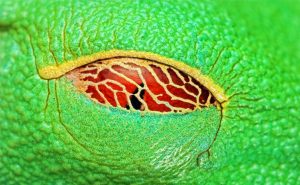What is a Nictitating Membrane?
You may have noticed on your pet cat or dog how there is fine membrane which covers their eyes when they are starting to relax. This is the nictitating membrane, also known as the nictitating eyelid or third eyelid. Nictitate, or nictate, comes from the Latin word meaning “wink.”

Nictitating membranes offer protection from environmental factors, during hunting and fighting, and as an additional way to lubricate and clean the eyes. You’ll recognize this cool feature on many sharks, amphibians, reptiles, cats, dogs, bears, camels, and birds, just to name a few.
Human beings only have a vestige of a third eyelid, which we call the plica semilunaris, Latin for “half-moon fold.” This is in the inner corner of your eye, but it’s not so easy to find, and if you wink, you’ll miss it.
Now, can you guess which animal is the owner of the beautiful nictitating membrane in the photo?